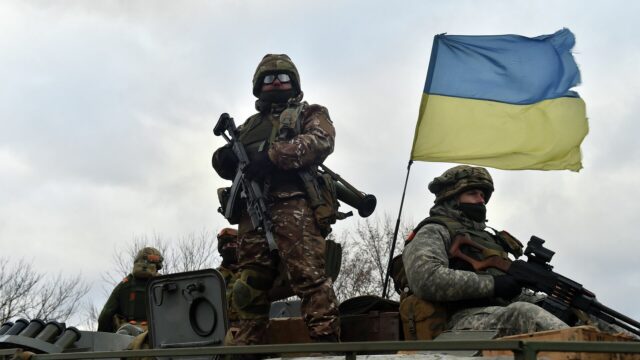
Bringing Russia Back From the Cold at Ukraine’s Expense (Part Two)
Publication: Eurasia Daily Monitor Volume: 20 Issue: 89
By:

*Read Part One here.
Another proposal for an armistice-in-place cutting across Ukraine’s territory has been aired for discussion, this time, from the Council on Foreign Relations (Foreign Affairs, April 13).
Politically, these proposals imply rehabilitating Russia as a partner in negotiations with the West (Moscow’s officially designated archenemy) and with Ukraine (the latest victim of Russian aggression). The proposed recourse to the United Nations and the Organization for Security and Co-operation in Europe (see Part One) seemingly ignores the UN Security Council’s (UNSC) and OSCE’s incurable crises stemming from Moscow’s veto power within both organizations (as well as Beijing’s in recent years in the UNSC). The authors also recommend approaching China and other influential countries to support the proposed ceasefire in Ukraine. Such an approach, however, looks inconsistent with the authors’ own idea that the United States should execute a relative disengagement from Ukraine to focus more on confronting China.
Assuming that the ceasefire across Ukraine holds, the authors recommend the start of peace talks on two parallel tracks. First, “direct talks between Ukraine and Russia, facilitated by international mediators [unspecified], on the terms of peace.” Second, and concurrently, “NATO [North Atlantic Treaty Organization] allies would start a strategic dialogue with Russia on arms control and the broader European security architecture.” The second track would, however, crown Russia’s rehabilitation as a credible and ostensibly necessary partner in European security. It would also signify heavy Western investment in the “success” of the second track (illusory in view of Russia’s record of behavior in such forums). And the parallelism of the two tracks would, therefore, result in privileging the Russia track at the expense of the Ukraine track.
Furthermore, to incentivize Russia, “the West could also offer some limited relief from sanctions, in return for Russia’s willingness to abide by a cease-fire, agree to a demilitarized zone, and participate meaningfully in peace talks.” Thus, sanctions relief would reward Russia for merely agreeing to a ceasefire while entrenched in Ukrainian territory and laying the active hostilities to rest on Russian terms. Russia, however, never abided by ceasefires in Ukraine, nor did it ever negotiate bona fide peace in Ukraine or elsewhere unless defeated in the field.
The authors expect Ukraine to enter such negotiations by pursuing its top priorities: the restoration of its 1991 borders, Russian reparations and Russian accountability for war crimes. They equally expect Russian President Vladimir Putin to “surely reject these demands out of hand. A diplomatic stalemate would then emerge, effectively producing a new frozen conflict.” This implies blaming the frozen conflict—should one ensue—on Ukraine and its “maximalist” goals.
The term “frozen conflict” is, however, inapplicable to Russia’s war against Ukraine. Even during the lifetime of the Minsk “agreements,” Russia never allowed this conflict to “freeze.” Ukraine and the West never had that option. Following the first phase of full-scale hostilities (2014–2015), Moscow continuously fueled low-intensity warfare to pressure Kyiv into political concessions. By 2021, Russia turned the pressure for political concessions on the West writ large. And the Kremlin will certainly not give Ukraine and the West the option of “freezing” the conflict this time. Defeating Russia in the field is the only available means to avoid another protracted, simmering conflict mischaracterized as “frozen.”
“Many Ukrainians would see this proposal as a sellout and fear that the cease-fire lines would merely become new de facto borders,” the authors concede. Consequently, “[Ukrainian President Volodymyr] Zelenskyy would need to dramatically scale back his war aims” to convince Ukrainian public opinion to go along—a tall order even for a politician of Zelenskyy’s caliber, the authors admit.
Yet, there are multiple misconceptions here. The war aims are not merely Zelenskyy’s but those of the Ukrainian nation and state. Nor are they “maximalist” but rather legal, legitimate and (ultimately) coterminous with the interests of the US in Europe and those of NATO writ large. Admittedly, the Biden administration never sought to defeat Russia in Ukraine and (perhaps for this reason) failed to articulate its own aims in supporting Ukraine to the limited extent it has thus far.
In incentivizing Ukraine, this time, to accept defeat in all but name, the authors prescribe to the European Union to “craft a long-term economic support pact and to propose a timetable for [Ukraine’s] admission to the EU, guaranteeing Ukraine that it is on the path toward full integration.” This proposal is untenable. The EU is an organization based on scrupulous adherence to its own procedures. It has already made clear that no country, not even Ukraine (especially considering its reform lags), is eligible for fast-track accession or “guaranteed” integration. Ukraine itself will know better than to accept this idea at face value should Washington offer it as a sweetener for a wholly unnecessary defeat.



